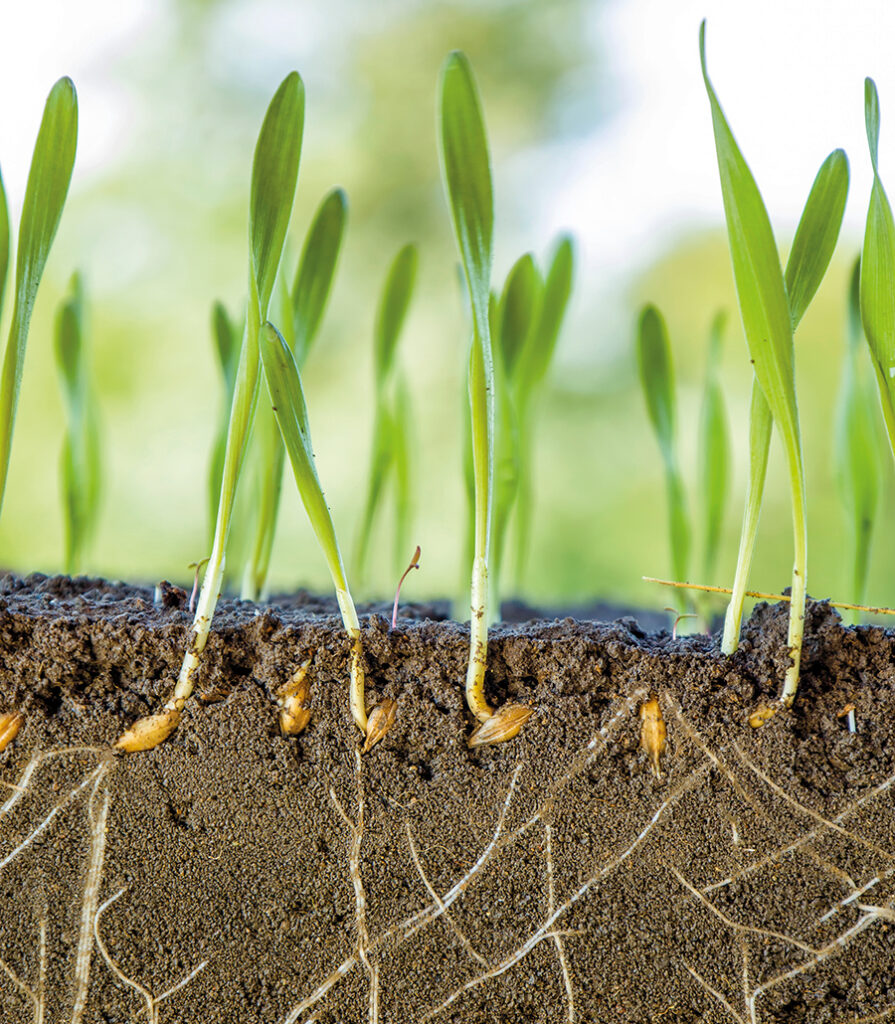Optimise autumn nutrition to build resilient crops
20th September 2024
Establishing a strong rooting system is fundamental to the resilience of all crops. Farmers Guide seeks expert advice on how best to achieve this through targeted soil nutrition.

When it comes to autumn nutrition, the starting point, as with so many aspects of crop agronomy, is to fully understand the soils on your farm, says Hutchinsons development manager, Jennie Watson.
“Nutrition and soils are so closely interlinked; we need a thorough understanding of the condition of soils to highlight any limiting factors and show where to focus our attention for nutrition over the season ahead.
“So often we’re talking about making use of nutrition that’s already in the soil, but unfortunately for whatever reason, may not be available to the plant. That can be for various reasons, from the chemistry causing nutrient lock-up, to an imbalance in soil biology, or physical structural issues preventing roots from getting down to where nutrients are. Our focus is on understanding how we can support plants to access that nutrition and make the most of anything else that’s applied.”
Autumn is a good time to assess soils, providing they are warm with sufficient moisture, and there are some simple visual tests growers can do themselves. But Ms Watson believes it is worth investing in more detailed analysis of physical, chemical and biological soil properties, such as through the Healthy Soils Gold test or Terramap Gold, to fully understand the complex interactions involved.
The Gold test, for example, includes an assessment of total nutrition in the soil, and what is available to plants, to allow a much more meaningful discussion around nutrition programmes.
“You won’t be able to act on everything that detailed analysis shows in one season, but it could help hone-in and prioritise the points you need to focus on. It all comes back to the principle of ‘measure to manage’. If we aren’t monitoring things, how do we know if we are moving forward or not?”
The cost is generally far outweighed by the potential benefits from improved nutrient use efficiency, fertiliser savings, and crop output, she adds.
Placement fertiliser benefit
Access to phosphate is a core focus for autumn nutrition, as the nutrient is integral to root development, Ms Watson continues.
Although soil indices can often suggest there is sufficient phosphate in soils, there can still be challenges in terms of plant availability given phosphate’s limited mobility and tendency to become complexed (locked-up) by other elements, such as calcium, iron or aluminium.
“Phosphate is so immobile, just putting it on the surface and expecting it to get to where it’s needed, just doesn’t work.”
The application of microgranular or liquid placement fertilisers close to seed at drilling can help mitigate this lack of mobility and offer significant benefits to early establishment, with far greater uptake efficiency than seedbed applied products – which can be as low as 10%.
“We’re placing a small amount of phosphate right near the seed just to get it off to a start. Once it starts putting down roots itself, these release root exudates, which we know help kick-start nutrient cycling, releasing more phosphate.”
Microgranular fertilisers by their nature are small, but are incredibly efficient, so much less product is required than with seedbed applied products – typically 10–20kg/ha compared with nearer 100kg/ha for TSP in some cases.
“Admittedly, not every farm has the kit to apply placement fertiliser, which is a challenge, but the number is increasing, and growers will definitely see the benefits.”
Biostimulants drive root architecture
The benefits from placement phosphate for kick-starting root development can be further enhanced with the use of phosphite-based biostimulants to build root biomass in the autumn, says Ms Watson.
“Last year we saw some clear benefits from using phosphites in the autumn to help late-sown plants struggling to root because of the conditions. This year, we could be looking at a different scenario of earlier drilling, but there could still be a benefit from building root biomass to support a potentially bigger crop canopy.
“Roots are so fundamental to accessing nutrition and supporting the development of plant biomass throughout the season, there’s a really good case for using phosphites.”
Phosphites are not a plant food in the same way as phosphate, she adds. “Phosphites act as a biostimulant, upregulating plant processes, increasing root growth and associated root exudates, which support the release and uptake of nutrition in the soil.
“There will still be a need to come back in the spring to provide nitrogen and the other nutrition that plants need, but in terms of supporting autumn growth, the focus is very much on kick-starting rooting and nutrient cycling.”
pH is fundamental
Finally, soil pH is a simple, but fundamental, factor to consider when planning crop nutrition, as it has such a big influence on the availability of many nutrients.
In acidic soils, for example, aluminium and manganese can become more available, potentially causing toxicity issues, while calcium, phosphorus, and magnesium are less available.
Most growers rectify low pH with lime post-harvest ahead of drilling, sequenced with cultivations to get the lime acting in the top layer of soil rather than waiting for worm activity to take it down.
However, Ms Watson says it is possible to still apply lime after drilling through to the spring, up to the point where any benefits are outweighed by risks of damaging the growing crop. “Knowing your pH is crucial for optimising nutrition,” she concludes.
Read more arable news
